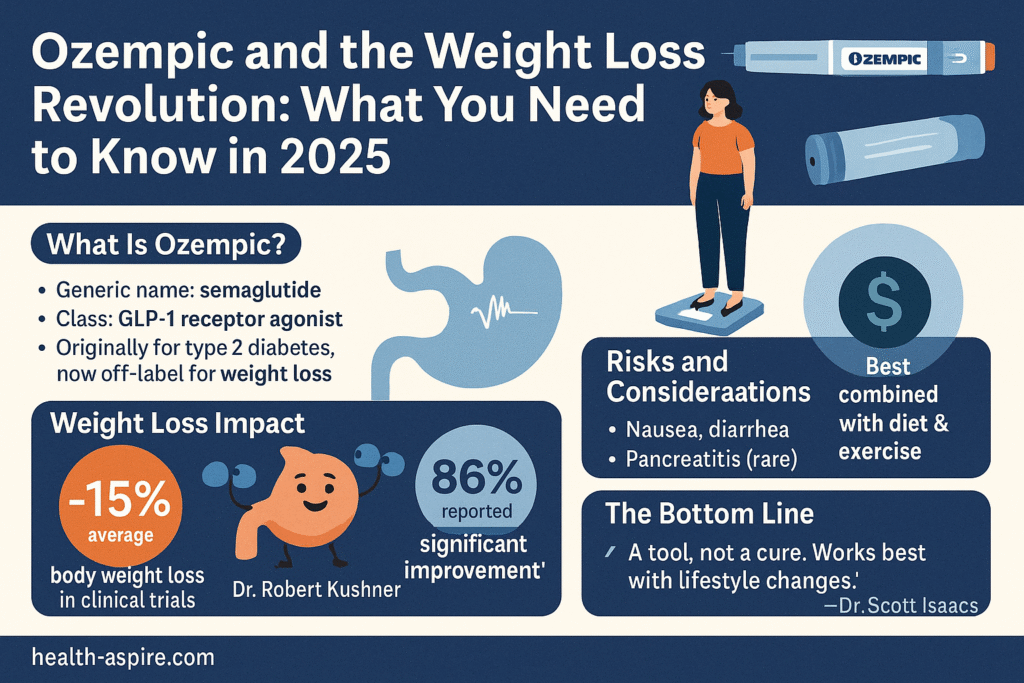Ozempic and the Weight Loss Revolution: What You Need to Know in 2025

The Hype Around Ozempic
In the last two years, Ozempic (semaglutide) has become one of the most searched health terms in the United States. Originally developed for type 2 diabetes, it’s now making headlines as a groundbreaking weight loss aid. According to Google Trends, searches for “Ozempic weight loss” have increased by over 300% in 2024 alone, and TikTok videos under the hashtag #Ozempic have generated 1.2 billion+ views.
But is Ozempic really a miracle drug for weight loss, or just another passing fad? Let’s dive into the facts, expert opinions, and what science actually says.
1. What Is Ozempic?
- Generic name: Semaglutide
- Class: GLP-1 receptor agonist (Glucagon-like peptide-1)
- Originally approved: For type 2 diabetes (FDA approval in 2017)
- New use: Off-label for weight loss; its sister drug Wegovy is officially approved for obesity management
💡 How it works:
Ozempic mimics the GLP-1 hormone, which regulates blood sugar, slows down digestion, and reduces appetite — making people feel full faster and longer.
2. What Do Studies Say?
- A 2022 study in The New England Journal of Medicine showed that patients lost an average of 15% of their body weight over 68 weeks while on semaglutide.
- According to the American Diabetes Association, semaglutide users reported better glycemic control and reduced cardiovascular risk.
- Dr. Robert Kushner, professor at Northwestern University, stated: “Semaglutide is the first medication that has shown weight loss outcomes comparable to bariatric surgery, without the invasiveness.”
📊 Quick Stats:
- FDA-approved doses for weight loss: 2.4 mg weekly (Wegovy)
- Average weight loss: 33 lbs (15 kg) over 16 months
- Success rate: ~86% of patients reported significant improvement
3. Side Effects and Concerns
Despite the hype, Ozempic is not risk-free. Common side effects include:
- Nausea and vomiting
- Diarrhea or constipation
- Stomach pain
- Rare: pancreatitis, thyroid tumors (in animal studies)
⚠️ Experts warn: Ozempic is not for everyone.
- Pregnant women and people with a history of medullary thyroid carcinoma should avoid it.
- Long-term safety data is still limited.
4. The Social Media Effect
One reason Ozempic exploded in popularity is celebrity and influencer buzz. High-profile names like Elon Musk and various Hollywood figures have hinted at GLP-1 use for weight management.
On TikTok:
- #Ozempic has 1.2B+ views
- #OzempicWeightLoss has 450M+ views
This online exposure has created what some call the “Ozempic Era” in dieting.
5. Costs and Accessibility
- Monthly cost (U.S.): $900–$1200 without insurance
- Insurance coverage: Limited, often only for diabetes patients
- Generic versions: Not yet widely available, but competition is expected in 2026
💡 This high cost raises ethical questions: should powerful weight-loss medications be accessible only to the wealthy?
6. Alternatives and Lifestyle Synergy
While Ozempic is effective, doctors stress that it works best when paired with:
- A high-protein diet to preserve muscle mass
- Regular exercise (cardio + resistance training)
- Stress management and proper sleep
🔗 Read also: Daily Habits to Enhance Concentration and Productivity
7. Expert Opinions
- Dr. Scott Isaacs, endocrinologist: “Ozempic is a tool, not a cure. Without lifestyle changes, patients often regain weight once they stop taking it.”
- Harvard Health Publishing emphasizes: “The drug shows promise but should be combined with a long-term commitment to healthy eating and activity.”
8. The Future of Weight Loss Medicine
Pharmaceutical companies are racing to release next-gen GLP-1 drugs with fewer side effects. Analysts predict the global weight-loss drug market could reach $100 billion by 2030, largely thanks to semaglutide.
Conclusion
Ozempic has undeniably changed the weight loss landscape, offering hope to millions struggling with obesity. But it’s not a magic bullet. It works best as part of a holistic approach — including nutrition, exercise, and mindful living.
As we step into 2025, Ozempic represents both an opportunity and a cautionary tale: a reminder that while medicine can help, lasting health is built on daily choices.








Greetings! Very helpful advice on this article! It is the little changes that make the biggest changes. Thanks a lot for sharing!
I am constantly looking online for ideas that can facilitate me. Thank you!
When I originally commented I clicked the -Notify me when new feedback are added- checkbox and now each time a remark is added I get four emails with the identical comment. Is there any manner you can take away me from that service? Thanks!
Thanks for sharing excellent informations. Your web site is so cool. I am impressed by the details that you¦ve on this blog. It reveals how nicely you perceive this subject. Bookmarked this web page, will come back for extra articles. You, my pal, ROCK! I found just the information I already searched everywhere and just could not come across. What a great web-site.
Excellent goods from you, man. I’ve be mindful your stuff prior to and you’re just too excellent. I actually like what you’ve received right here, really like what you’re saying and the best way in which you assert it. You are making it entertaining and you continue to care for to keep it smart. I cant wait to learn much more from you. That is really a wonderful site.
Whats Taking place i am new to this, I stumbled upon this I have found It absolutely helpful and it has helped me out loads. I hope to contribute & help other users like its helped me. Great job.